Hundreds of hikers found themselves fighting for survival on Mount Everest after an unexpectedly fierce blizzard battered the mountain’s eastern slopes in Tibet, stranding nearly 1,000 people and triggering a massive rescue operation over the first weekend of October 2025. The storm, which began as rain before escalating into sleet and finally a full-on blizzard, struck at the height of the region’s climbing season, catching trekkers and guides off guard and putting their lives at risk.
According to Chinese state media and reports from Reuters, the blizzard began on the evening of October 3 and persisted through October 4, 2025, dumping around one meter (about three feet) of snow in the remote Karma valley, which leads to Everest’s eastern Kangshung face. The snow, mixed with heavy rainfall and even thunder and lightning, rapidly transformed the usually bustling trekking routes into a landscape fraught with danger. The timing was especially unfortunate: the storm hit during China’s eight-day National Day holiday, when hundreds of visitors flocked to the area to take advantage of the clear skies that typically follow the Indian monsoon.
By October 6, approximately 350 hikers had managed to descend safely to the township of Qudang, aided by local rescuers, villagers, and support staff using horses and oxen to clear snow-blocked paths. But the ordeal was far from over for the hundreds more who remained stranded on the slopes. CCTV, China’s state broadcaster, reported that contact had been established with more than 200 people still stuck on the lower slopes, and that rescue teams were guiding groups down in stages. The operation was complicated by relentless snowfall, deep drifts, and the sheer remoteness of the affected campsites.
“About one-third into the trek, it began to rain and the rain kept getting heavier,” recounted Chen Geshuang, a member of an 18-person trekking team who spoke with NBC News and Reuters. “Later, it turned into sleet, and eventually a full-on blizzard.” Chen described a harrowing night in which her team began to show signs of mild hypothermia and cold stress, forcing them to retreat. “It was a nerve-wracking night,” she said, adding that when she woke up on October 5, “the snow was extremely deep—about 1 meter, reaching up to our thighs.”
The ferocity and suddenness of the storm stunned even seasoned guides. “The weather this year is not normal,” Chen emphasized. “It was so wet and cold in the mountains. The guide said he had never encountered such weather in October. And it happened all too suddenly.” Her group, like many others, was greeted with hot drinks and sweet tea by villagers in Qudang after their ordeal, a small comfort after a night of heavy snowfall, thunder, and lightning.
Eric Wen, another climber who was forced to turn back, told Reuters that visibility was so poor he “did not see Everest at all” during the trek. “We only had a few tents. More than 10 of us were in the large tent and hardly slept,” Wen said. His group had to shovel snow every 10 minutes to prevent their tents from collapsing under the weight. Despite being well-equipped, two men and a woman in his party suffered mild hypothermia when temperatures plunged below freezing.
State-backed Jimu News reported that hundreds of local villagers and rescue teams were deployed to clear snow and open access to the stranded hikers. Video footage released by Tibet media showed long lines of people with horses and oxen making their way up winding, snow-covered paths to reach those trapped. The rescue effort was a community-wide mobilization, with villagers and officials working side by side to bring hikers down from elevations above 16,000 feet.
Tragically, not everyone survived the ordeal. According to Xinhua, a 41-year-old male hiker died of hypothermia and acute altitude sickness during the storm. In another mountainous region of western China, a separate hiker lost his life under similar conditions, and 137 others were evacuated from Menyuan county in Qinghai province. Meanwhile, across the border in Nepal, heavy rains triggered landslides and flash floods that killed at least 50 people, including 37 in the eastern Ilam district. A South Korean trekker also died on Mera Peak, his body recovered by rescue helicopter, as reported by Nepal’s National Mountain Guides Association.
Mount Everest, standing at roughly 29,032 feet (8,848 meters) above sea level, is the world’s highest mountain and a perennial draw for climbers and trekkers from around the globe. The region’s October climbing season is typically marked by stable weather and clear skies, which follow the end of the Indian monsoon. This year, however, conditions were anything but typical. The storm forced authorities to suspend ticket sales and entry to the Everest Scenic Area late on October 4, as safety concerns mounted and rescue operations took precedence.
The stranded hikers were primarily in tourist campsites—distinct from the higher-altitude climbing base camps used by those attempting the summit—located in the lush, relatively untouched Karma valley. Unlike the arid north face of Everest, the eastern slopes are characterized by alpine forests and vegetation nourished by meltwaters from the Kangshung glacier. The valley was first explored by Western travelers a century ago and remains one of the less-traveled yet most scenic routes in the Everest region.
While the immediate focus has been on search and rescue, the incident has also highlighted the risks of high-altitude trekking, especially in unpredictable weather. Hypothermia, a condition where the body loses heat faster than it can produce it, was a real threat throughout the ordeal. According to USA TODAY, hypothermia can be fatal if not recognized and treated quickly, particularly in remote environments where help may be hours or days away. The Himalayan Database notes that more than 340 people have died on Mount Everest over the years, with over 200 bodies remaining on the mountain due to the difficulty and danger of recovery.
The snowstorm’s impact extended beyond the physical dangers. It disrupted the plans of hundreds of holidaymakers and underscored the challenges of emergency response in one of the world’s most inhospitable environments. Yet, it also revealed the resilience and solidarity of both the local communities and the international trekking community. As one hiker told Jimu News, “Otherwise our tents would have collapsed.” It was a sentiment echoed by many: survival hinged on teamwork, quick thinking, and the tireless efforts of rescuers and villagers alike.
As the last groups of hikers continue to make their way down to safety, the story of the 2025 Everest blizzard stands as a stark reminder of nature’s unpredictability and the enduring spirit of those who venture into the world’s wildest places.





